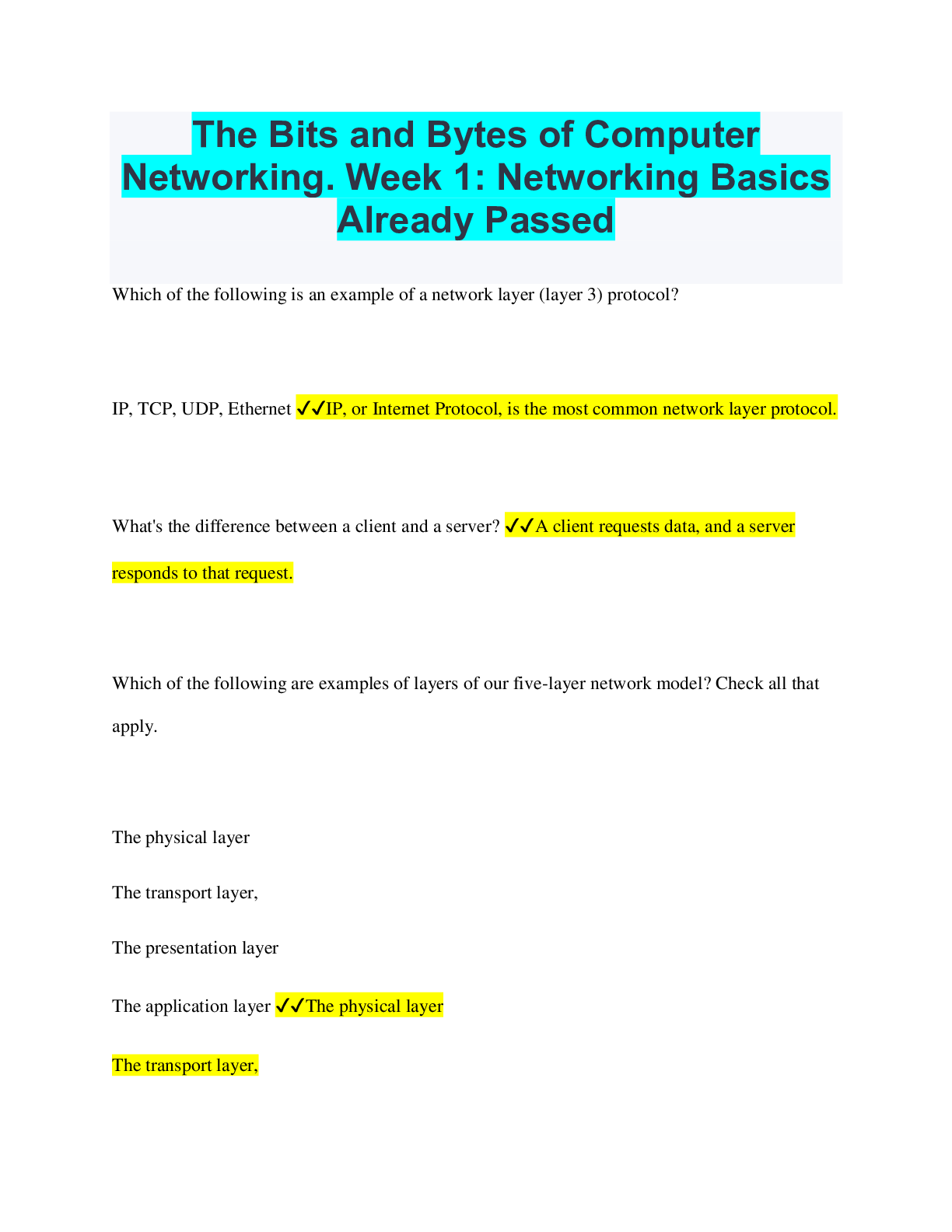Computer Networking > QUESTIONS & ANSWERS > The Bits and Bytes of Computer Networking. Week 2: The Network Layer Already Passed (All)
The Bits and Bytes of Computer Networking. Week 2: The Network Layer Already Passed
Document Content and Description Below
The Bits and Bytes of Computer Networking. Week 2: The Network Layer Already Passed Please select all of the valid IP addresses. Check all that apply. 8.8.8.8, 123.456.123.456, 192.168.1.1, 257.70... .312.49 ✔✔8.8.8.8, 192.168.1.1 How many IP addresses does a class C network have? ✔✔254 addresses What does CIDR stand for? ✔✔CIDR stands for Classless Inter-Domain Routing Which of the following is a correct form of CIDR notation? ✔✔192.168.1.0/24; CIDR notation uses a forward slash and then lists the numbers of bits in the subnet mask. How many octets does a subnet mask have? ✔✔4; A subnet mask is the same length as an IP address. Select examples of routing protocols. Check all that apply. ✔✔Border Gateway Protocol/ Routing Information Protocol Who is permitted to use non-routable address space? ✔✔Anyone; Anyone can use non-routable address space. A typical routing table may contain which of the following? Check all that apply. ✔✔Total hops/ Destination network An ARP broadcast is sent to the special MAC address ________. ✔✔FF:FF:FF:FF:FF:FF; ARP broadcasts are used to ask all devices on a local area network if they're associated with a specific IP address. The process of taking a large network and splitting it up into many individual and smaller subnetworks is known as ________. ✔✔Subnetting; Subnetting allows for much finer-grained controls of network sizes than the old class system could support. TTL stands for _______. ✔✔Time to Live; TTL is used to make sure that an undeliverable packet doesn't spend all of eternity waiting for delivery. Ranges of IP addresses that anyone can use for their internal networks are known as ______. ✔✔Non-routable address space; Non-routable address space can be used by anyone. In binary, 1 +1 = _____. 2, 10, 1, 0 ✔✔not 1 Calculate how many decimal numbers a 4-bit number can represent. 256, 4, 16, 8 ✔✔not 256; Please review the videos in the "Network Layer" module for a refresher. A router is performing basic routing functions. What will be the third step in the transmission of a packet? ✔✔The router looks up the destination network in its routing table; The router looks up the destination network of the IP address in its routing table in the third step. How many bits long is an IP address? ✔✔32 bits; IP addresses are 32-bit-long numbers made up of four octets, and each octet is normally described in decimal numbers. Which number cannot be represented by eight bits of data? ✔✔436; Eight bits of data, or a single octet, can represent all decimal numbers from 0-255. 436 is beyond this limit. Which IP address is Class C? ✔✔192.37.48.98; Class C addresses begin with a first octet value of 192 through 223. What protocol is used to discover the hardware address of a node with a certain IP address? ✔✔ARP table; An ARP table is just a list of IP addresses and the MAC addresses associated with them. What is the process of taking a large network and splitting it up into many individual and smaller subnetworks called? ✔✔Subnetting; Subnetting is the process of taking a large network and splitting it up into many individual and smaller subnetworks, or subnets. What is the maximum decimal number possible to represent with 16 bits? 256, 1600, 16, 65536 ✔✔not 256; Not quite. Please review the videos in the "Basic Binary Math" module for a refresher. How many possible host IDs do you always lose per network? ✔✔2; You always lose two host IDs per network. So, if a /24 network has 2^8 or 256 potential hosts, you really only have 256 - 2 = 254 available IPs to assign. Which are a type of interior gateway protocol? (Check all that apply) ✔✔Link state routing protocols; Link state protocols get their name because each router advertises the state of the links of each of its interfaces. This information about each router is propagated to every other router on an autonomous system. Distance-vector protocols; A router using a distance vector protocol basically just takes its routing table, which is a list of every network known to it and how far away these networks are in terms of hops. Then the router sends this list to every neighboring router, which is basically every router directly connected to it. [Show More]
Last updated: 1 year ago
Preview 1 out of 5 pages
Instant download
.png)
Buy this document to get the full access instantly
Instant Download Access after purchase
Add to cartInstant download
Also available in bundle (1)
.png)
The Bits and Bytes of Computer Networking Bundled Exams (Week 1-6) Questions and Answers Already Passed
The Bits and Bytes of Computer Networking Bundled Exams (Week 1-6) Questions and Answers Already Passed
By Nutmegs 1 year ago
$20
9
Reviews( 0 )
Document information
Connected school, study & course
About the document
Uploaded On
Feb 07, 2023
Number of pages
5
Written in
Additional information
This document has been written for:
Uploaded
Feb 07, 2023
Downloads
0
Views
104

.png)
.png)
.png)
.png)
.png)
.png)
.png)
.png)
.png)
.png)
.png)


 Answered 2023.png)
.png)
.png)
.png)
.png)
.png)

